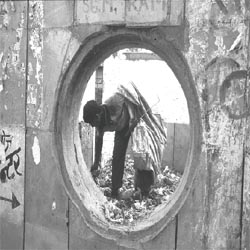Left picking wastes
 They are seen almost everywhere, rummaging through heaps of garbage. The police harass them and the local people view them with suspicion. Hardly anyone understands the importance of their work. Ragpickers, in fact, do the municipalities a big favour by collecting recyclable wastes from the dump to sell it to the recycling industry. It is estimated that these wastepickers collect about 12-15 per cent of the total waste produced in large urban areas. It is estimated that the Municipal Corporation of Delhi (MCD) spends about Rs 620 on collection and disposal of one tonne of waste. The city generates approximately 5,000 tonnes of waste per day. Considering that the ragpickers collect 12-15 per cent of the total waste, they save the MCD between Rs 3,72,000 to Rs 4,50,000 every day.
They are seen almost everywhere, rummaging through heaps of garbage. The police harass them and the local people view them with suspicion. Hardly anyone understands the importance of their work. Ragpickers, in fact, do the municipalities a big favour by collecting recyclable wastes from the dump to sell it to the recycling industry. It is estimated that these wastepickers collect about 12-15 per cent of the total waste produced in large urban areas. It is estimated that the Municipal Corporation of Delhi (MCD) spends about Rs 620 on collection and disposal of one tonne of waste. The city generates approximately 5,000 tonnes of waste per day. Considering that the ragpickers collect 12-15 per cent of the total waste, they save the MCD between Rs 3,72,000 to Rs 4,50,000 every day.
The waste-pickers generally collect paper, plastics, metal, glass and rags. Besides, there are several waste purchasers, better known as kabariwallahs, who move from house to house buying reusable material. A large number of traders buy this recyclable material from them at a very low cost and pass on the material to the industry at a high price.
A very extensive network of ragpickers exists in the informal sector. However, according to an Interim Report, filed by a committee set up by the Supreme Court, "An effort to organise the wastepickers is a difficult task as the people involved in purchasing the materials work against the interest of wastepickers. Therefore, efforts made to organise them are sabotaged by such vested interests.'
Asked if anyone of them has ever realised or anybody had ever told them about the importance of their work, Hira Gajghate, a 50-year-old ragpicker in Pune, shakes her head with complete ignorance.
